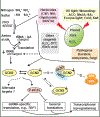Review: Emerging roles of the signaling network of the protein kinase GCN2 in the plant stress response
- PMID: 35643606
- PMCID: PMC9197246
- DOI: 10.1016/j.plantsci.2022.111280
Review: Emerging roles of the signaling network of the protein kinase GCN2 in the plant stress response
Abstract
The pan-eukaryotic protein kinase GCN2 (General Control Nonderepressible2) regulates the translation of mRNAs in response to external and metabolic conditions. Although GCN2 and its substrate, translation initiation factor 2 (eIF2) α, and several partner proteins are substantially conserved in plants, this kinase has assumed novel functions in plants, including in innate immunity and retrograde signaling between the chloroplast and cytosol. How exactly some of the biochemical paradigms of the GCN2 system have diverged in the green plant lineage is only partially resolved. Specifically, conflicting data underscore and cast doubt on whether GCN2 regulates amino acid biosynthesis; also whether phosphorylation of eIF2α can in fact repress global translation or activate mRNA specific translation via upstream open reading frames; and whether GCN2 is controlled in vivo by the level of uncharged tRNA. This review examines the status of research on the eIF2α kinase, GCN2, its function in the response to xenobiotics, pathogens, and abiotic stress conditions, and its rather tenuous role in the translational control of mRNAs.
Keywords: Amino acids; Innate immunity; Reactive oxygen; Ribosome stalling; Translation initiation; tRNA.
Copyright © 2022 Elsevier B.V. All rights reserved.
Conflict of interest statement
Declaration of Competing Interest
The authors report no competing interests.
Figures




Similar articles
-
Regulation of translation initiation by amino acids in eukaryotic cells.Prog Mol Subcell Biol. 2001;26:155-84. doi: 10.1007/978-3-642-56688-2_6. Prog Mol Subcell Biol. 2001. PMID: 11575165 Review.
-
Differential requirements for P stalk components in activating yeast protein kinase Gcn2 by stalled ribosomes during stress.Proc Natl Acad Sci U S A. 2023 Apr 18;120(16):e2300521120. doi: 10.1073/pnas.2300521120. Epub 2023 Apr 12. Proc Natl Acad Sci U S A. 2023. PMID: 37043534 Free PMC article.
-
Human Keratinocyte Differentiation Requires Translational Control by the eIF2α Kinase GCN2.J Invest Dermatol. 2017 Sep;137(9):1924-1934. doi: 10.1016/j.jid.2017.04.029. Epub 2017 May 17. J Invest Dermatol. 2017. PMID: 28528168 Free PMC article.
-
p58IPK is an inhibitor of the eIF2α kinase GCN2 and its localization and expression underpin protein synthesis and ER processing capacity.Biochem J. 2015 Jan 15;465(2):213-25. doi: 10.1042/BJ20140852. Biochem J. 2015. PMID: 25329545
-
New functions of protein kinase Gcn2 in yeast and mammals.IUBMB Life. 2012 Dec;64(12):971-4. doi: 10.1002/iub.1090. Epub 2012 Nov 5. IUBMB Life. 2012. PMID: 23129244 Review.
Cited by
-
Phosphoglycerate dehydrogenase is required for kernel development and defines a predominant serine synthesis pathway in maize.Plant Cell. 2025 Jun 4;37(6):koaf126. doi: 10.1093/plcell/koaf126. Plant Cell. 2025. PMID: 40403140 Free PMC article.
-
Transcriptome Analysis Reveals the Stress Tolerance Mechanisms of Cadmium in Zoysia japonica.Plants (Basel). 2023 Nov 12;12(22):3833. doi: 10.3390/plants12223833. Plants (Basel). 2023. PMID: 38005730 Free PMC article.
-
Stress sensing and response through biomolecular condensates in plants.Plant Commun. 2025 Feb 10;6(2):101225. doi: 10.1016/j.xplc.2024.101225. Epub 2024 Dec 18. Plant Commun. 2025. PMID: 39702967 Free PMC article. Review.
-
Plant translational reprogramming for stress resilience.Front Plant Sci. 2023 Feb 24;14:1151587. doi: 10.3389/fpls.2023.1151587. eCollection 2023. Front Plant Sci. 2023. PMID: 36909402 Free PMC article. Review.
-
Modulation of GCN2 activity under excess light stress by osmoprotectants and amino acids.Plant Signal Behav. 2022 Dec 31;17(1):2115747. doi: 10.1080/15592324.2022.2115747. Plant Signal Behav. 2022. PMID: 36093942 Free PMC article.
References
-
- Merchante C, Stepanova AN, Alonso JM, Translation regulation in plants: an interesting past, an exciting present and a promising future, Plant J, 90 (2017) 628–653. - PubMed
Publication types
MeSH terms
Substances
Grants and funding
LinkOut - more resources
Full Text Sources
Miscellaneous

